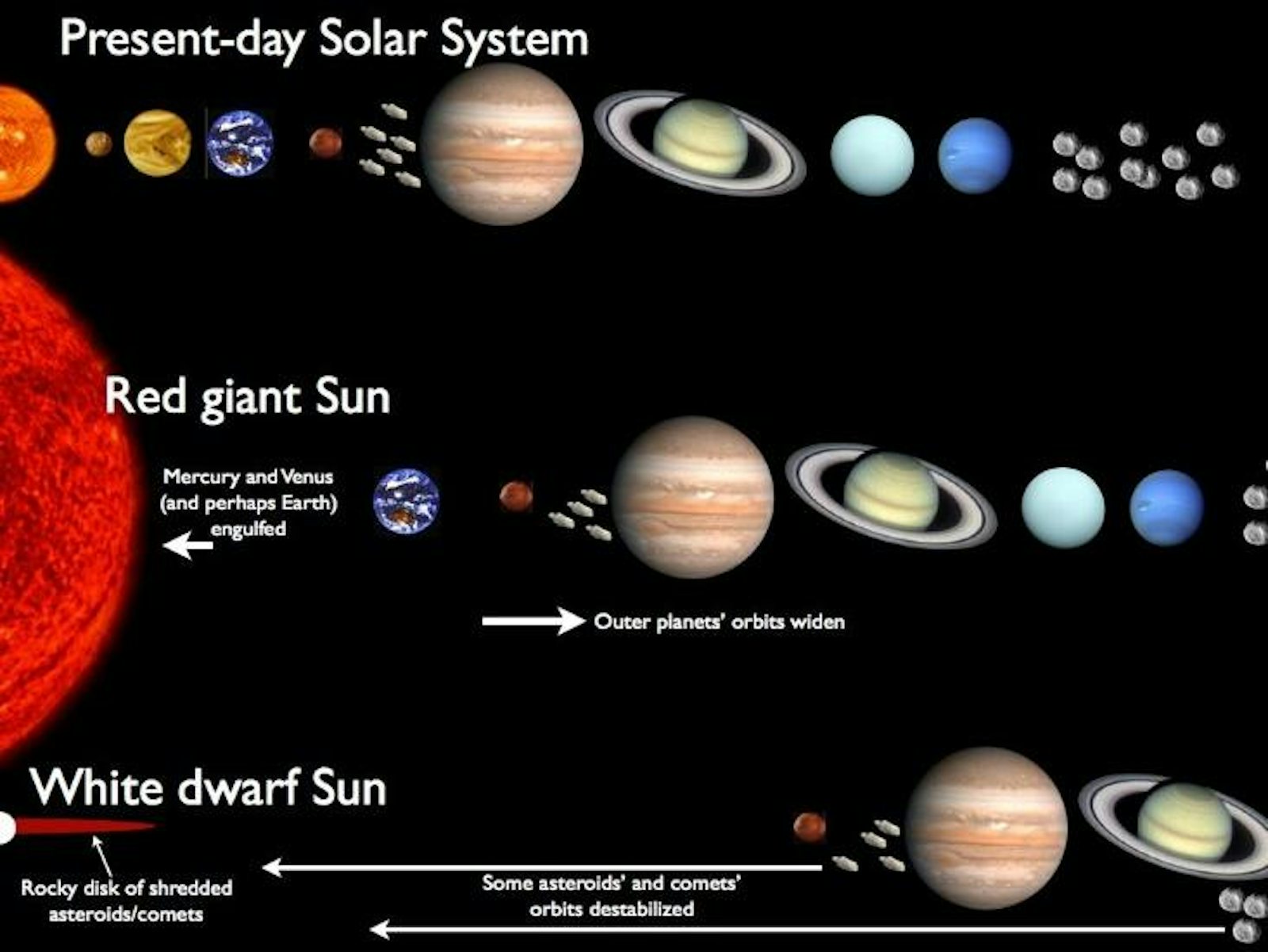Ever notice how pretty much all superhero movies are origins stories? Everyone wants to know how Batman and Wolverine and the Hulk became who they are. But there aren’t too many superhero-in-old-age stories out there, with balding, hunchbacked super-oldsters hobbling around assisted-living homes.
The same goes for the Solar System. The question of how the Solar System formed has been pondered by scientists for hundreds of years. And it is by no means a solved problem; the study of planet formation remains a thriving subfield within astrophysics. But there are just a handful of researchers studying the future of the Solar System.
The Sun has been around for four and a half billion years. It hasn’t changed all that much in that time. Life on Earth is doing fine. Why should we even be thinking about the distant future? Because when astronomers look closely at stars, they routinely see the deaths of planets! Well, not the moment of death itself. Rather, they detect the “blood spatter” created by the deaths of planetary systems. Astronomers detect this spatter in the spectra of white dwarfs, the skeletons of dead stars.
It turns out that the Sun does change; it just takes its time. The Sun today is 30 percent brighter than just after its birth 4.57 billion years ago. Its slow ramp-up will continue for another five billion years, then something dramatic will happen. The Sun’s core will run out of hydrogen, the fuel of its fusion reactor. The Sun will continue to fuse hydrogen in a shell, and this will puff the Sun up into a red giant. Red giants are cooler than Sun-like stars (hence their redness) but are extremely luminous due to their very large sizes. Betelgeuse, Orion’s bright right shoulder, is a good example of a red giant.
The Sun will remain a red giant for a few hundred million years. This is an interesting period for life, because Saturn will be near the same temperature as Earth is today, so its moons Titan and perhaps Enceladus, already intriguing to exobiologists, may be habitable.
The planets’ orbits will adjust to the changing Sun. The inner planets will be engulfed when the Sun is a red giant. Planets far from the Sun will expand onto wider orbits as the Sun loses mass to powerful winds flowing out from its surface. As the Sun’s gravity weakens, a planet’s orbit naturally widens, like a slinky losing its tension and stretching out with age. Now, a red giant is big. The Sun will expand by about a factor of 100 to become a red giant and will extend out about as far as Earth’s current orbit. Our planet is at the brink: We don’t know whether it will be swallowed by the Sun or escape onto a larger orbit. (Of course, this will have no importance for life because Earth’s oceans are expected to boil away in the next couple billion years, long before the Sun goes red giant and completely fries the planet.)
Meanwhile, the Sun’s core will contract until the increased temperature and pressure can fuse helium. There will be a few flashes before the Sun puffs off its outer layers as a “planetary nebula” (which has nothing to do with planets but is an old name that stuck around). What will remain of the Sun is its core, a small white dwarf that does nothing but slowly cool off for eternity. White dwarfs are only about the size of Earth despite being almost as massive as the Sun. As such, they have extremely strong surface gravities, and any material heavier than hydrogen or helium settles out of their atmospheres and into the stars themselves in days to months, an astronomical blink of the eye.

When we look at white dwarfs, a large fraction of them appear to be “polluted”: Instead of having pure hydrogen or helium spectra, their outer layers are contaminated with rocky material. Because it should settle out very quickly, this rocky material must have collided with the white dwarf very recently. This is the blood spatter marking the scene of the crime. But what exactly is the crime?
Here is how we think the story goes. As the orbits of the planets change, as the star becomes a red giant and then a white dwarf, belts of asteroids and comets often find themselves in unstable configurations. These small bodies are gravitationally slingshotted in all directions, and some come very close to the white dwarf. Since a white dwarf is a tiny target, small bodies do not crash into the star but instead are torn to pieces by its gravity. This creates a disk of debris in a close orbit around the white dwarf that slowly trickles onto the star’s surface and produces the observed pollution.
A nice symmetry in this story is that polluted white dwarfs tell us not only about the deaths of planetary systems, but also about their births. Asteroids and comets are essentially leftovers from planet formation, and the pollution measured in several white dwarfs has the same composition as meteorites that have fallen to Earth! Planets in those systems are probably built of the same building blocks as ours. A few white dwarfs show signs of pollution from water-rich asteroids; these asteroids may be telling us that Earth-like planets in those systems could have had lakes and oceans. Unfortunately, given that these are dead planetary systems, these lakes and oceans are long gone.
In 6 billion years, the Sun will be a white dwarf. Earth will have either been swallowed by the red giant Sun or just thoroughly roasted. Viewed by a distant observer, the only hint that a pale blue dot once orbited this dime-a-dozen white dwarf will be a few distinctive spectral lines—the blood spatter from a long-dead planetary system.
Sean Raymond is an astronomer studying the formation and evolution of planetary systems. He also blogs at planetplanet.net.


























